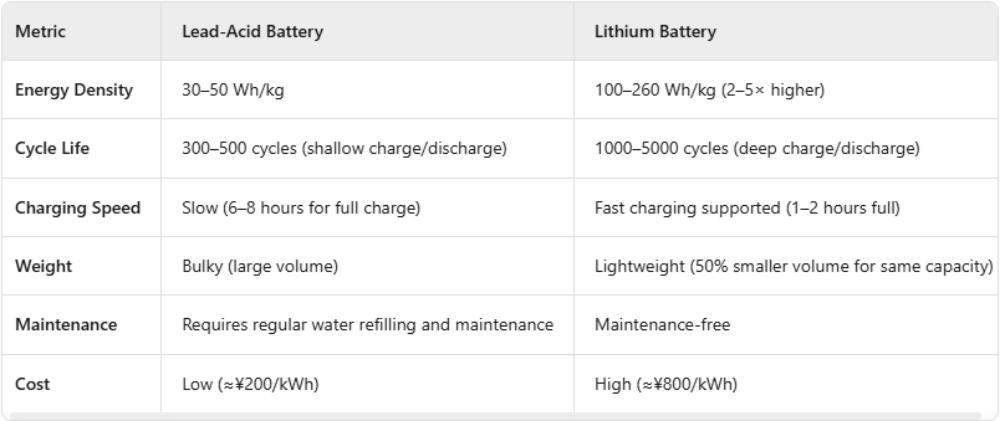Lead-acid batteries and lithium batteries are the current mainstream energy storage technologies, but they differ significantly in performance, lifespan, cost, etc. This article will compare the characteristics of the two in depth to help you choose the appropriate technology route based on your needs.
1. Basic definition and core technology
(1) Lead-acid Battery
Core technology: Using lead and lead dioxide as electrodes and sulfuric acid solution as electrolyte, energy is stored through chemical reactions.
Features: Low cost and mature technology, but low energy density, heavy weight, and requires regular maintenance (such as rehydration).
(2) Lithium-ion Battery
Core technology: Relying on the insertion/deinsertion of lithium ions between the positive and negative electrodes to achieve charging and discharging, using lightweight materials (such as graphite negative electrode, lithium cobalt oxide/lithium iron phosphate positive electrode).
Features: High energy density, long cycle life, supports fast charging, but is sensitive to temperature and requires battery management system (BMS) protection.
Core technology: Using lead and lead dioxide as electrodes and sulfuric acid solution as electrolyte, energy is stored through chemical reactions.
Features: Low cost and mature technology, but low energy density, heavy weight, and requires regular maintenance (such as rehydration).
(2) Lithium-ion Battery
Core technology: Relying on the insertion/deinsertion of lithium ions between the positive and negative electrodes to achieve charging and discharging, using lightweight materials (such as graphite negative electrode, lithium cobalt oxide/lithium iron phosphate positive electrode).
Features: High energy density, long cycle life, supports fast charging, but is sensitive to temperature and requires battery management system (BMS) protection.
2. Core Parameter Comparison
3. Differences in application scenarios
(1) Application areas of lead-acid batteries
Car starter battery: relies on its low cost and reliability.
Low-speed electric vehicles (such as mobility scooters for the elderly): low energy density requirements.
Backup power supply: such as UPS uninterruptible power supply (frequent maintenance required).
(2) Lithium batteries dominate the field
Electric vehicles: Tesla, BYD, etc. all use lithium batteries to meet the demand for long battery life.
Consumer electronics: Mobile phones and laptops rely on the thin and light design of lithium batteries.
Energy storage system: Grid-level energy storage power stations choose lithium batteries to improve energy efficiency.
Car starter battery: relies on its low cost and reliability.
Low-speed electric vehicles (such as mobility scooters for the elderly): low energy density requirements.
Backup power supply: such as UPS uninterruptible power supply (frequent maintenance required).
(2) Lithium batteries dominate the field
Electric vehicles: Tesla, BYD, etc. all use lithium batteries to meet the demand for long battery life.
Consumer electronics: Mobile phones and laptops rely on the thin and light design of lithium batteries.
Energy storage system: Grid-level energy storage power stations choose lithium batteries to improve energy efficiency.
4. Why are lithium batteries becoming mainstream?
(1) Technical advantages
High energy density: At the same volume, the capacity of lithium batteries is more than 3 times that of lead-acid batteries.
Long life: Many cycles and lower long-term use costs (although the initial investment is high).
Environmental protection: No heavy metal pollution (lead-acid batteries contain lead, which is difficult to recycle).
(2) Market trends
Policy promotion: Various countries’ plans to ban the sale of fuel vehicles have accelerated the penetration of lithium batteries in the automotive field.
Cost reduction: Technological advances have reduced the price of lithium batteries by 80% in ten years.
High energy density: At the same volume, the capacity of lithium batteries is more than 3 times that of lead-acid batteries.
Long life: Many cycles and lower long-term use costs (although the initial investment is high).
Environmental protection: No heavy metal pollution (lead-acid batteries contain lead, which is difficult to recycle).
(2) Market trends
Policy promotion: Various countries’ plans to ban the sale of fuel vehicles have accelerated the penetration of lithium batteries in the automotive field.
Cost reduction: Technological advances have reduced the price of lithium batteries by 80% in ten years.
 +86 13332949210
+86 13332949210 info@xihobattery.com
info@xihobattery.com







 Xiho
Xiho Apr 18 2025
Apr 18 2025










